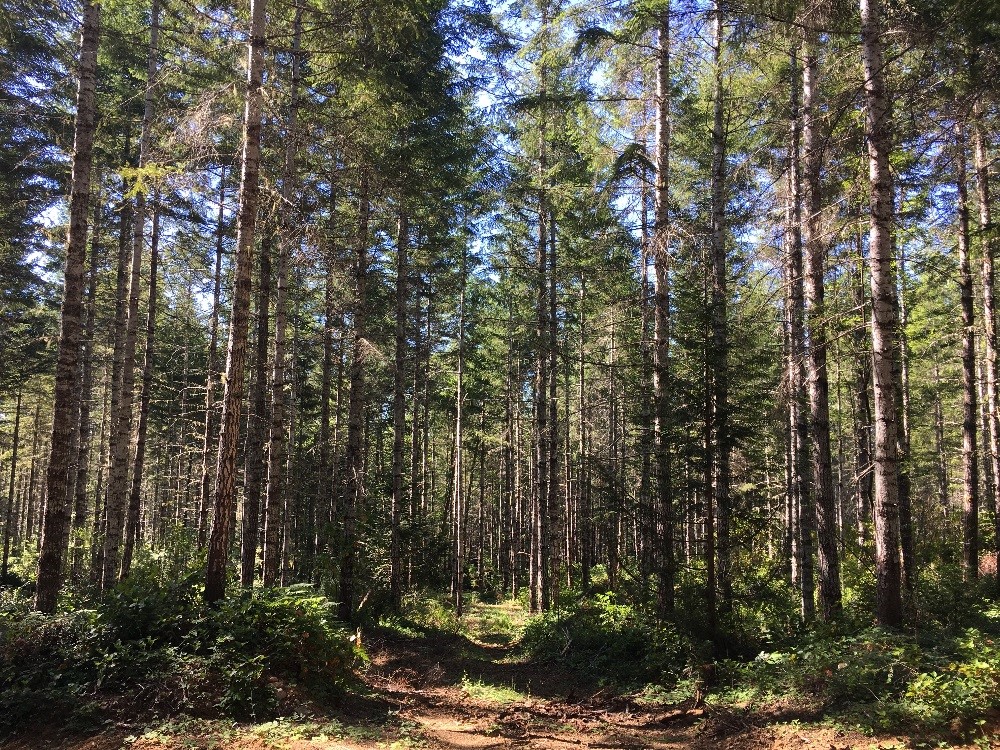By Jennifer Hushaw, Applied Forest Scientist, Climate Services Program

River flowing under the Hama Hama bridge into Hood Canal, Puget Sound, Washington. Photo credit: Jennifer Hushaw
Manomet’s Climate Services team (including Senior Program Leader Eric Walberg and myself) recently visited Washington state to meet with one of the newest members of the Climate Smart Land Network—as well as other potential partners, including Weyerhaeuser, Laird Norton Family Foundation, and Northwest Natural Resource Group.

Hama Hama Company sign describing the history of ownership. Photo credit: Jennifer Hushaw
Our visit with Hama Hama Company (a CSLN member since 2016) was a highlight of our trip. Located along Hood Canal on the beautiful Olympic Peninsula, Hama Hama (so named for the river running through the property) is most well-known as a fifth generation shellfish farm, but they are also in the business of growing trees. Their 5,000-acre certified Tree Farm has been managed for timber for close to 100 years. These days the property is managed by Tom and Kendra James, who have a unique opportunity to shape an entire system by managing the watershed that feeds their oyster beds in the nearby canal.
During our visit, we learned about Hama Hama’s land base, operations, and long- term goals, including a visit to a stand of Douglas-fir they had recently thinned to improve growth on the residual trees (see photo below). We also discussed their emerging concerns and questions related to climate change. Their region is expected to experience “a continued shift in the geographic distribution of species, changes in forest growth and productivity, increasing fire activity, and changing risks from insects, diseases, and invasive species,” as noted in a 2015 report from the University of Washington. They are also likely to “experience an ongoing decrease in snowpack” and “a continued shift from snow to rain.” These changes in the hydrologic cycle are something they are watching closely. Kendra noted that a nearby mountain was almost bare of snow in recent years, at a time when it would normally have significant visible snowpack.

View of a recent commercial thinning operation in a stand of Douglas-fir. Photo credit: Jennifer Hushaw
For forest managers, the foremost concerns related to climate can vary from one region to the next, e.g. drought-related dieback in the west, heavy downpours damaging infrastructure in the northeast, etc. The practice of forestry is itself variable across regions, with different tree species, topography, logging equipment, timber markets, land ownership patterns, forest pests, post-harvest planting versus natural regeneration, and more. At ~18.1 million acres, lands enrolled in the CSLN are currently concentrated in the north and southeastern U.S., but expansion into new geographic regions (through the addition of members like Hama Hama) is hugely beneficial because it increases the potential for learning and collaboration within the Network. Managers who are beginning to think about operating in novel conditions can gain valuable insight by learning what challenges and solutions their colleagues are wrestling with in other regions. Through the CSLN, we help facilitate this information sharing and outline the big picture trends in forest response to climate change.
Our contacts at Hama Hama have the same forward-thinking mentality that is shared by all CSLN members—a desire to understand the implications of a changing climate and think proactively to ensure that our forests continue to be a productive timber resource, a haven for wildlife, an effective carbon sink, and more. Hama Hama’s connection to the sea (through their oyster business) gives them a unique perspective because changes are happening much more rapidly in ocean systems (i.e. acidification) than on land. While climate-induced changes in our forests will take longer to manifest, they may be no less dramatic over the long term.
At the time of our visit, a great example of the dynamic nature of the marine environment was underway, as the Hood Canal was a brilliant aquamarine color due to an ongoing algal bloom.

Satellite image of the bloom captured July 30, 2017. Source: NASA Earth Observatory
The tiny crustaceans responsible for giving the water its brilliant hue are known as coccolithophores (read more about them here). These non-toxic blooms happen periodically and there has been some suggestion that an observed increase in coccolithophores over recent decades could be associated with rising carbon dioxide in the ocean (although the exact nature of that relationship remains to be seen).* By forming their microscopic shells out of carbon, these blooms are also an important carbon sink over the long term (in much the same way that our forests act as a carbon sink). Not only do they play a role in the modern day carbon cycle, but they are also important for the study of past climate. The chemical composition of their calcium carbonate shells indicates water temperature and salinity, creating a record of ocean conditions that is preserved when they die, sink to the bottom, and become incorporated into deep ocean sediments.
* https://hub.jhu.edu/2015/11/26/rapid-plankton-growth-could-signal-climate-change/





 Back to all
Back to all